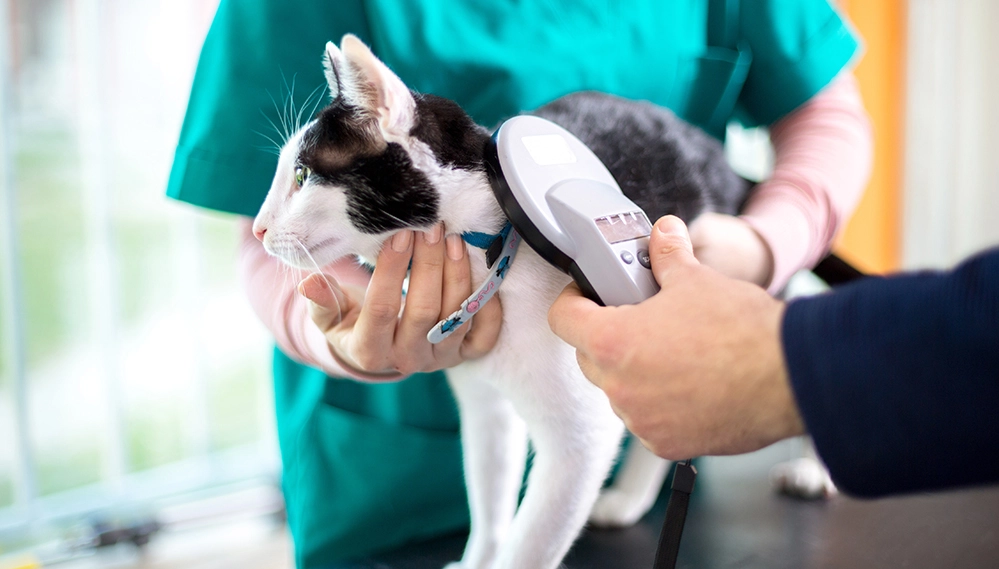How Pet Microchips Work to Keep Your Pet Safe

Oh no, Sadie got out again!
When our doggos or kitties manage a great escape, our first reaction as pet parents is to panic. Of course, we want to start searching, put up signs, and notify neighbors or post on Nextdoor.com. But panic won’t help bring our fur baby home safely.
Every year, millions of pets go missing in the United States. Pet microchips are one of the most effective ways to ensure your lost pet can be reunited with you, even if their collar falls off or they’re taken far from home. Unlike collars and tags that can break, get lost, or be removed, a microchip is permanent, tamper-proof, and lasts a lifetime.
What are pet microchips and why do they matter?
I’m the pet parent of a former wanderer. When my Chihuahua, Ricky, was young, he loved exploring the neighborhood by sneaking under the backyard fence, no matter how many times I filled the holes or stacked bricks along the bottom! Fortunately, he was always found, either by me or a neighbor, and his adventures always had a happy ending. But that wasn’t just luck.
While I didn’t keep a collar on Ricky 24/7, I made sure he was microchipped. That tiny chip gave me peace of mind every time he decided to go on an adventure.

Understanding pet microchips: what they do and how they help
What is a pet microchip?
A microchip is a tiny electronic device containing your contact information. It’s about the size of a grain of rice and is painlessly implanted just under your pet’s skin by a vet, and no anesthesia is required. The cost is minimal, around $25, and the chip is registered in a national database.
Collars are a great way to identify pets, but they can fall off, break, or even become a choking hazard if caught on a fence or branch. A microchip, however, is permanent and works even if your pet is stolen or travels far from home.
How a microchip helps track your lost pet
If your lost pet is brought to a vet, shelter, or animal control, they will scan the chip, retrieve your information, and contact you immediately. The scanning process is quick, painless, and standard procedure at shelters and veterinary clinics across the country.
However, keeping your contact details current is crucial. If you move, change your phone number, or your name changes, notify the microchip registry immediately. Adding an emergency contact is also a wise precaution in case you can’t be reached right away.

Real stories: How microchips saved the day
Microchipping has helped countless pets find their way home. Here are just two examples:
🐾 Thanos’ Story: At just 4 months old, Thanos was stolen from his backyard. After a fortunate reunion, his owner immediately had him microchipped. Later, when he managed to get out of the yard again, an officer found him, scanned his chip, and 24Petwatch quickly notified his owner. Thanos was home within hours.
🐾 Castiel’s Adventure: Castiel escaped through an upstairs bedroom window and made his way to the neighbor’s garage sale! Thankfully, a kind woman took him to a local vet, where they scanned his chip. Since his owner was at work and missed the calls, 24Petwatch contacted his owner’s emergency contact, her dad, who made sure Castiel got home safely.
These stories prove that this simple technology works, even in unexpected situations.
Why every pet needs a microchip
Bergen County Veterinary Center in New Jersey emphasizes another critical benefit of microchipping: it prevents unnecessary euthanasia. Stray pets without identification are often euthanized if their owners cannot be located within a certain timeframe. A microchip connects them to their families, dramatically decreasing these tragic outcomes.
Microchips also provide proof of ownership if your pet is stolen or if there’s a dispute about who owns the animal. This legal protection can be invaluable.
Getting and maintaining your pet’s microchip
Getting your pet microchipped is simple:
- Schedule an appointment with your veterinarian or local animal shelter
- The procedure takes just minutes. The chip is injected under the skin between the shoulder blades
- Register the chip with your contact information in the national database
- Keep your information updated whenever your contact details change
Many shelters and rescue organizations microchip pets before adoption, so your pet may already have one. Ask your vet to scan for a chip if you’re not sure.
Protect your pet: Why microchipping matters
For just a small investment, a pet microchip can be the difference between heartbreak and a happy reunion with your lost pet. If your pet isn’t microchipped yet, consider scheduling an appointment. You’ll never regret having that extra layer of security for your beloved fur baby.
Whether your pet is an escape artist like my Ricky or a homebody who’s never wandered, accidents happen. Gates get left open. Storms spook pets. Disasters strike unexpectedly.
Microchipping ensures that no matter what happens, your pet can always find their way back to you. Your future self, and your pet, will thank you.





